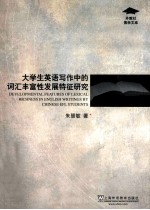图书介绍
大学生英语写作中的词汇丰富性发展特征研究PDF|Epub|txt|kindle电子书版本网盘下载

- 朱慧敏著 著
- 出版社: 上海:上海外语教育出版社
- ISBN:9787544634410
- 出版时间:2013
- 标注页数:264页
- 文件大小:39MB
- 文件页数:287页
- 主题词:英语-写作-教学研究-高等学校;英语-词汇-教学研究-高等学校
PDF下载
下载说明
大学生英语写作中的词汇丰富性发展特征研究PDF格式电子书版下载
下载的文件为RAR压缩包。需要使用解压软件进行解压得到PDF格式图书。建议使用BT下载工具Free Download Manager进行下载,简称FDM(免费,没有广告,支持多平台)。本站资源全部打包为BT种子。所以需要使用专业的BT下载软件进行下载。如BitComet qBittorrent uTorrent等BT下载工具。迅雷目前由于本站不是热门资源。不推荐使用!后期资源热门了。安装了迅雷也可以迅雷进行下载!
(文件页数 要大于 标注页数,上中下等多册电子书除外)
注意:本站所有压缩包均有解压码: 点击下载压缩包解压工具
图书目录
ChapterOne Introduction1
1.1 Background ofthe Study1
1.2 Rationale for the Study5
1.3 Purpose and Method ofthe Study8
1.4 Significance ofthe Study10
1.5 Organization ofthe Book13
Chapter Two Literature Review16
2.1 Introduction16
2.2 Definitions of Lexical Richness17
2.3 Measures for Lexical Richness20
2.4 Role ofVocabulary in L2 Writing28
2.5 Developmental Features of Vocabulary in L2 Writing29
2.6 Lexical Richness in Writings by L1 and L2 Learners34
2.7 Lexical Richness and L2 Writing Quality36
2.8 Lexical Features of L2 Writing40
2.9 Research Gaps and Research Questions49
2.10 Chapter Summary52
Chapter Three Methodology54
3.1 Introduction54
3.2 Special Considerations for Research Design55
3.3 Participants57
3.4 Source of Data58
3.5 Pilot Study59
3.6 Procedures for Data Collection60
3.7 Building the DIY Corpora65
3.8 Data Analysis74
3.9 Chapter Summary84
Chapter Four Results and Findings of the Cross-sectional Study86
4.1 Introduction86
4.2 Features of Lexical Variation86
4.3 Features of Lexical Density89
4.4 Features of Lexical Sophistication91
4.5 Features ofWord Length94
4.6 Features of Word Frequency Distribution97
4.7 Relationship between Lexical Richness and Overall Writing Performance101
4.8 Chapter Summary105
Chapter Five Results and Findings of the Longitudinal Study106
5.1 Introduction106
5.2 Features of Lexical Variation106
5.3 Features of Lexical Density109
5.4 Features of Lexical Sophistication110
5.5 Features ofWord Length112
5.6 Features of Word Frequency Distribution115
5.7 Relationship between Lexical Richness and119
Overall Writing Performance119
5.8 Chapter Summary122
Chapter Six Resultsand Findingsa cross the Two Corpora123
6.1 Introduction123
6.2 Patterns and Discrepancies in Lexical Variation123
6.3 Patterns and Discrepancies in Lexical Density126
6.4 Patterns and Discrepancies in Lexical Sophistication129
6.5 Patterns and Discrepancies in Word Length132
6.6 Pattems and Discrepanciesin Word Frequency Distribution134
6.7 Patterns and Discrepancies in the Relationships between Lexical Richness and Overall Writing Performance140
6.8 Chapter Summary142
Chapter Seven Results and Findings of the Case Studies143
7.1 Introduction143
7.2 Results of KeynessAnalysis143
7.3 Developmental Features of"we"147
7.4 Developmental Features of"you"149
7.5 Developmental Features of"l"151
7.6 Developmental Features of"can"152
7.7 Developmental Features of"know"155
7.8 Developmental Features of"so"159
7.9 Chapter Summary165
Chapter Eight Discussion167
8.1 Introduction167
8.2 Overuse of High-frequency Words168
8.3 Vocabulary Plateau Phenomenon in Lexical Variation170
8.4 Models of Developmental Features of Lexical Richness173
8.5 Unbalanced Effects of Lexical Richness on the Overall Writing Performance179
8.6 The Most Overused First and Second Personal Pronouns181
8.7 The Most Overused Modal Auxiliary193
8.8 The Most Overused Lexical Word196
8.9 The Most Overused Multi-function Word202
8.10 Chapter Summary205
Chapter Nine Conclusion206
9.1 Summary ofthe Study206
9.2 Pedagogical Implications209
9.3 Limitations ofthe Study223
9.4 Suggestions for Future Studies224
9.5 Concluding Remarks225
References227
Appendix Ⅰ Prompts of WritingTask244
Appendix Ⅱ Marking Scheme for TEM-4 and TEM-8 Compositions245
Appendix Ⅲ Stop List247
Appendix Ⅳ UCRELCLAWS7Tagset257
Acknowledgements263